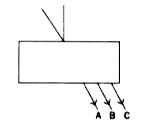A: When a narrow pulse of light is sent through a medium, it doesn't retain its shape as it travels through the medium.
R: Since the speed of propagation in a medium depends on wavelength , different wavelength components of the pulse travel with different speeds.
IF both Assertion & Reason are true and the reason is the correct explanation of the assertion, then mark (1).
If both Assertion & Reason are true but the reason is not the correct explanation of the assertion, then mark(2)
IF Assertion is true statement but Reason is false then mark(3)
If both Assertion and Reason are false statements, then mark (4)
The correct Answer is:A
To solve the question, we need to analyze both the assertion and the reason provided.
1. Understanding the Assertion:
- The assertion states that when a narrow pulse of light is sent through a medium, it does not retain its shape as it travels through the medium. This implies that the pulse spreads out or changes shape while propagating.
2. Understanding the Reason:
- The reason given is that the speed of propagation in a medium depends on the wavelength. Different wavelength components of the pulse travel with different speeds. This means that if the pulse consists of multiple wavelengths, each wavelength will travel at a different speed in the medium.
3. Analyzing the Effect of Wavelength on Speed:
- The speed of light in a medium can be expressed as V=f×λ, where V is the speed, f is the frequency, and λ is the wavelength.
- When light enters a medium from air, the wavelength changes due to the refractive index of the medium, but the frequency remains constant. Therefore, if the wavelength changes, the speed of light in the medium will also change.
4. Implication of Different Speeds:
- Since different wavelengths travel at different speeds, the components of the pulse will separate as they propagate through the medium. This leads to the distortion of the pulse shape, confirming the assertion.
5. Conclusion:
- Both the assertion and the reason are true. The reason correctly explains why the assertion is true. Therefore, the correct answer is that both the assertion and reason are true, and the reason is the correct explanation for the assertion.
Final Answer:
Both assertion and reason are true, and the reason is the correct explanation for the assertion.
---
- The assertion states that when a narrow pulse of light is sent through a medium, it does not retain its shape as it travels through the medium. This implies that the pulse spreads out or changes shape while propagating.
- The reason given is that the speed of propagation in a medium depends on the wavelength. Different wavelength components of the pulse travel with different speeds. This means that if the pulse consists of multiple wavelengths, each wavelength will travel at a different speed in the medium.
- The speed of light in a medium can be expressed as V=f×λ, where V is the speed, f is the frequency, and λ is the wavelength.
- When light enters a medium from air, the wavelength changes due to the refractive index of the medium, but the frequency remains constant. Therefore, if the wavelength changes, the speed of light in the medium will also change.
- Since different wavelengths travel at different speeds, the components of the pulse will separate as they propagate through the medium. This leads to the distortion of the pulse shape, confirming the assertion.
- Both the assertion and the reason are true. The reason correctly explains why the assertion is true. Therefore, the correct answer is that both the assertion and reason are true, and the reason is the correct explanation for the assertion.
Both assertion and reason are true, and the reason is the correct explanation for the assertion.
Similar Questions
Mark the correct light ray as it travels through different mediums.

View SolutionA: Speed of light in a medium is independent of the motion of the source relative to the medium.
R: Speed of light in a medium depends on the motion of the observer relative to the medium.
View SolutionState two factors on which the speed of a wave travelling in a medium depends.
View SolutionLight travels with different speeds in different mediums.
View SolutionA: The speed of light, sound waves, water waves in a medium is independent of the nature of the source of intensity (so long it is low).
R: Speed of the waves in a medium depends on wavelength.
View SolutionSound travels with different speeds in different mediums.
View SolutionAssertion When a wave travels from a denser to a rarer medium, its amplitude increases.
Reason In a rarer medium, speed of wave is more
View SolutionAssertion: When a wave travels from a denser medium to rarer medium, then ampltitude of oscillation increases.
Reason: In denser medium, speed of wave is less compared to a rarer medium.
View SolutionThe speed of a wave in a medium is 760 m/s. If 3600 waves are passing through a point in the medium in 2 min, then their wavelength is
View SolutionWhen light travels from a rarer to denser medium, it loses some speed. Does the reduction in speed imply a reduction in the energy carried by the light wave ?
View Solution
